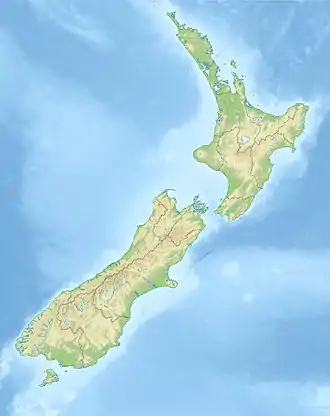Aotea Lagoon
Aotea Lagoon is an artificial lagoon surrounded by a 7-hectare (17-acre) public park in the Papakowhai suburb of Porirua, North Island, New Zealand.[1] Aotea and two nearby lagoons were created when major arterial transport links were realigned from the natural coastline to land reclaimed from Porirua Harbour.
| Aotea Lagoon | |
|---|---|
.jpg.webp) A view from the north-east: Pipitea miniature railway station across the lagoon, State Highway 1, North Island Main Trunk Railway and Porirua Harbour to the right. | |
 Aotea Lagoon | |
| Location | North Island |
| Coordinates | 41°7′12″S 174°51′25″E |
| Type | artificial lagoon |
| Primary inflows | Porirua Harbour and stormwater drains |
| Primary outflows | Porirua Harbour |
| Basin countries | New Zealand |
| Surface area | 5 ha (12 acres)[1] |
| Shore length1 | 732 m (2,402 ft) |
| Surface elevation | sea level |
| Settlements | Papakowhai[1] |
| 1 Shore length is not a well-defined measure. | |
Hydrology
The lagoon is 5 hectares (12 acres) of seawater,[1] connected to Porirua Harbour by a culvert under the model windmill.[2] Stormwater drains empty into the lagoon,[3] two in the east bank and a third in the south-east.
The lagoon's "water body receives limited flushing and aeration" and "little can be done to improve water quality without extensive engineering works."[3] Poor water quality means swimming is prohibited.[4]
History
The North Island Main Trunk railway and State Highway 1 used to run round three bays between Porirua and Paremata.
In the early 1960s, the railway was realigned to a causeway built between headlands at the mouth of Porirua Stream, Gear Homestead, present-day Thurso Grove and Brora Crescent.[5] Cut off from the sea, the bays became lagoons.
To realign the highway, on the inland side of the railway, the lagoons were partly filled in with material from the Ministry of Works and Development's nearby earthworks.
The Ministry, Porirua City Council, Project Employment Programme and local service clubs turned the area around the middle lagoon into a public aquatic park that opened as Aotea Lagoon in 1980. Originally leased from the Crown, the park was taken over by the City Council in 1994.
Facilities

The park's centrepiece is a path around the lagoon.
The Waitangirua Lions built a ¼ scale ridable miniature railway with an 833-metre (2,733 ft) loop track including two bridges and a tunnel.[6] The train runs Sunday afternoon, weather permitting, from Pipitea Station south-west of the lagoon. [7]
The park has lawns on three sides, some with barbecues. Other facilities from the north to south-east are adventure and toddlers' playgrounds, duck pond crossed by boardwalk, splash pad, island reached by bridge, Pétanque terrain and a rose garden.
Most people visit Aotea Lagoon for exercise or relaxation while children enjoy the playgrounds, feeding the ducks, riding bicycles and the train.[8]
Notes
- Porirua City Council 1994, p. 1.
- Porirua City Council 1994, p. 7.
- Porirua City Council 1994, p. 40.
- Porirua City Council 1994, p. 38.
- Porirua Library.
- Canterbury Society of Model and Experimental Engineers 2002, p. 2.
- Porirua City Council 2017.
- Jacobson 2009, p. 2.
References
- Porirua City Council (1994). Aotea Lagoon Management Plan (Report). Porirua Library: Porirua City Council.CS1 maint: ref=harv (link)
- Porirua Library. "Historic site: Aotea Lagoon". Archived from the original on 1 February 2019. Retrieved 2021-01-04.CS1 maint: ref=harv (link)
- Canterbury Society of Model and Experimental Engineers (April 2002). "Mini Railways in New Zealand" (PDF) (2nd ed.). Archived from the original (PDF) on 2010-05-26. Retrieved 2021-01-04.CS1 maint: ref=harv (link)
- Porirua City Council (16 October 2017). "It's full steam ahead for Aotea Lagoon's miniature train". Porirua City Council. Retrieved 2021-01-04.
- Jacobson, Christine (2009). Aotea Lagoon Visitor Monitoring 2009 (Report). Porirua City Council.CS1 maint: ref=harv (link)